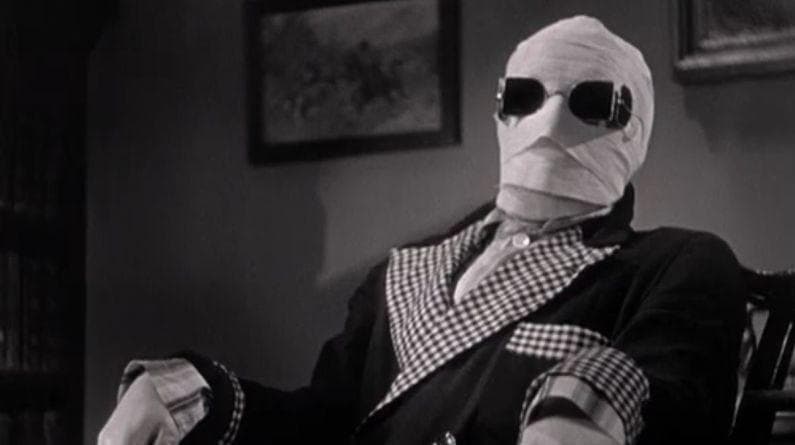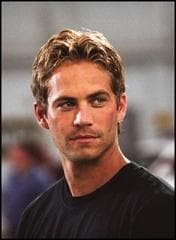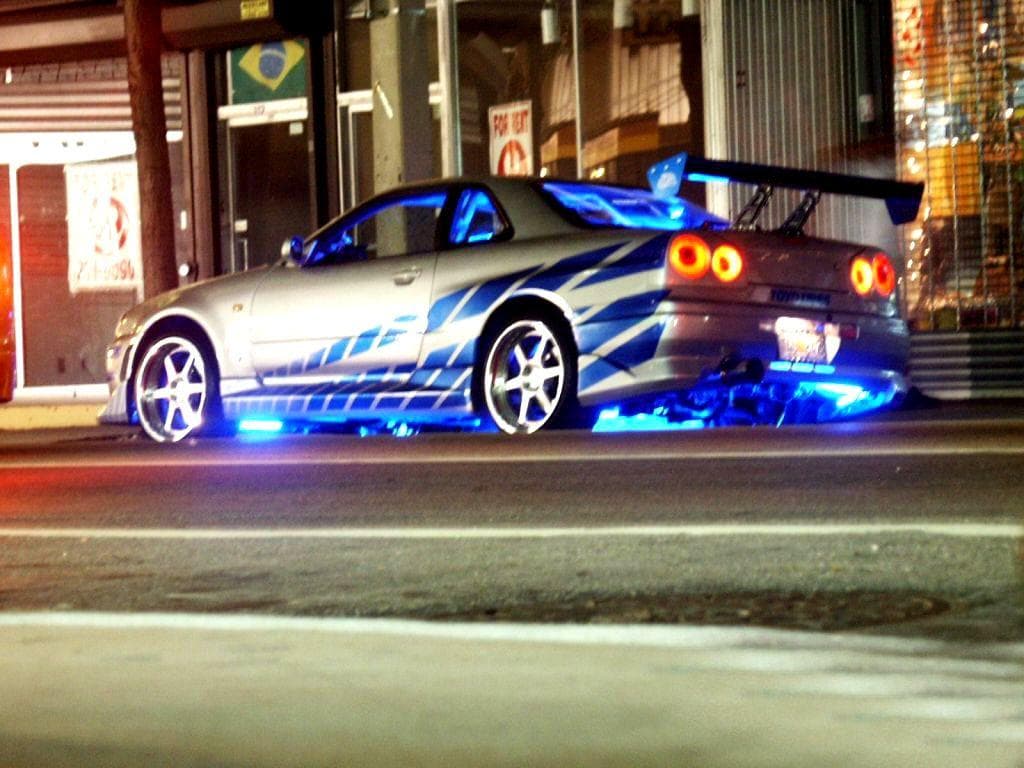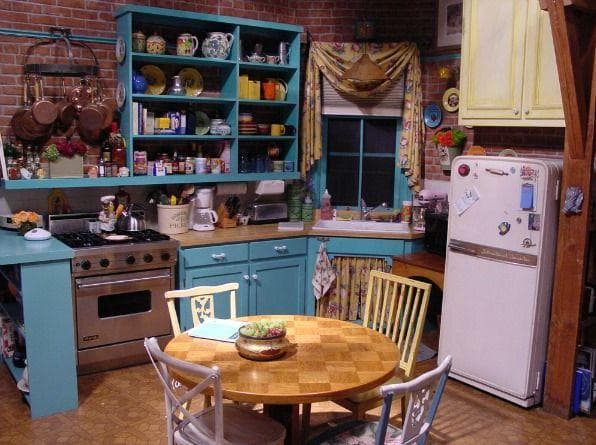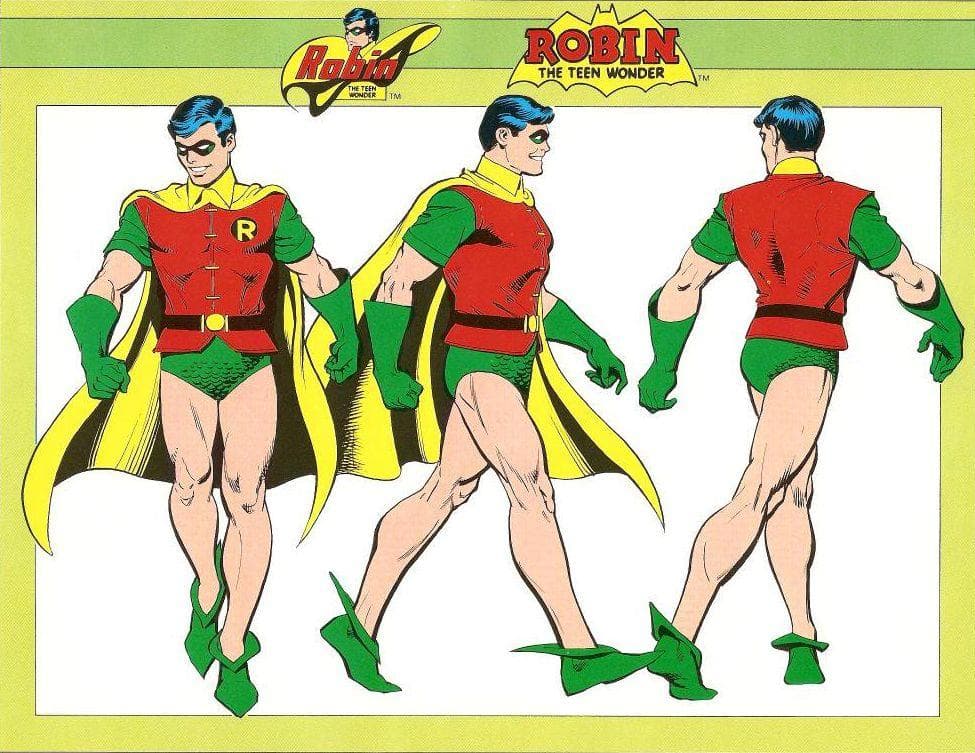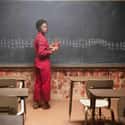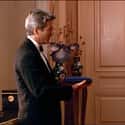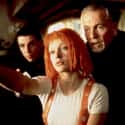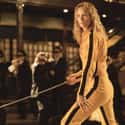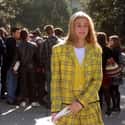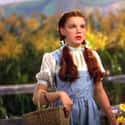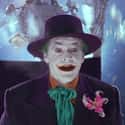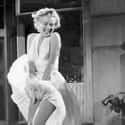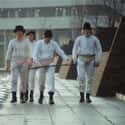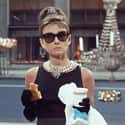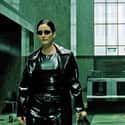-
(#1) Us
- Lupita Nyong'o, Winston Duke, Elisabeth Moss, Tim Heidecker, Shahadi Wright Joseph, Evan Alex, Yahya Abdul-Mateen II, Anna Diop
To understand the meaning of the red jumpsuits in Jordan Peele's Us, you first have to understand the twist ending, so consider this a spoiler alert if you haven't seen it. The whole film is about the "Tethered," who live in subterranean tunnels and are connected to people above the surface. Four of these doppelgangers, led by Red (Lupita Nyong'o), come out to terrorize Adelaide (also Nyong'o) and her family. In the film's final act, it is revealed that Adelaide is actually the Tethered version. She escaped as a child and made the real Adelaide take her place underground. The one we know as Red, in other words, is the one who came from the normal world.
Red is a bold primary color, often considered "hot" and frequently associated with violence or warfare, which is how it's used here. The now-grown "real Adelaide" is angry about having been forced into a life she was not meant to live. Therefore, she and her cohorts wear the color when they escape and make their way above ground. Kym Barrett, the costume designer for Us, said that was a very deliberate choice meant to reflect the character's rage. “She completely enshrouds her being with this red,” Barrett told The Atlantic. “It’s a symbol of aggression, a screaming mission. You cannot miss it.”
Furthermore, the "fake Adelaide" always wears white, and her clothes become more covered in blood as the story advances. According to Barrett in the same interview, this was to connect Red to Adelaide, so that by the end, "she's almost as red as Red."
-
(#2) Pretty Woman
- Julia Roberts, Richard Gere, Hank Azaria, Jason Alexander, Amy Yasbeck, Laura San Giacomo, Garry Marshall, Larry Miller, Ralph Bellamy, Héctor Elizondo, Elinor Donahue, Bill Applebaum, Charles Minsky, Alex Hyde-White, Al Sapienza, James Patrick Stuart, Dey Young, Larry Hankin, Amzie Strickland, Norman Large, Tommy Nolan, Walter Stacy Keach, Tracy Reiner, Frank Campanella, Kathleen Marshall, Lloyd Nelson, Abdul Salaam El Razzac, Billy Gallo, Patrick Richwood, Lynda Goodfriend, Rodney Kageyama, Judith Baldwin, Lucinda Crosby, Valorie Armstrong, Scott Marshall, Jimmy Dunne, Jackie O'Brien, John David Carson, Julie Paris, Mariann Aalda, Robyn Peterson, Steve Restivo, Reed Anthony, Carol Williard, Allan Kent, Marty Nadler, Lloyd T. Williams, Don Feldstein, Jeff Michalski, Jason Randal, Calvin Remsberg, Gary Greene, Tracy Bjork, Michael French, Nancy Locke, R.C. Everbeck, Randall Rutledge, Blair Richwood, Mychael Bates, Laurelle Mehus, Harvey Keenan, Rhonda Hansome, Douglas Stitzel, R. Darrell Hunter, Minda Burr, Daniel Bardol, Bruce Eckstut, Cheri Caspari, Karin Calabro, Shane Ross
In the rom-com classic Pretty Woman, working girl Vivian (Julia Roberts) is hired by wealthy businessman Edward (Richard Gere) to accompany him for a week. He gradually transforms her into a swan during the movie's most famous scene, where she emerges wearing an elegant red dress. Red, as we all know, is associated with extreme emotions, most notably passionate love.
The association with love should be clear in the sense that we know Vivian and Edward have fallen for each other by this point. Yet it also represents her self-love. By the time she dons the dress, Vivian has transcended her troubled background, seeing herself as a lady. For the first time in the story, she radiates pure confidence and is now able to view herself in a different light. It's a deliberately stark contrast to the white outfit we initially see her in.
-
(#3) The Life Aquatic with Steve Zissou
- Cate Blanchett, Bill Murray, Willem Dafoe, Owen Wilson, Jeff Goldblum, Anjelica Huston, Michael Gambon, Matthew Gray Gubler, Noah Taylor, Noah Baumbach, Seymour Cassel, Bud Cort, Waris Ahluwalia, Eric Chase Anderson, Seu Jorge, Jacques Henri Lartigue, Robert Graham, Isabella Blow, Hal Yamanouchi, Antonio Monda, Stefano Maria Ortolani, Daniel Acon, Pawel Wdowczak, Rudd Simmons, Robyn Cohen, Niccolò Senni, Nazzareno Piana, Anna Orso, Niels Koizumi, Stefano Masciolini, Taiyo Yamanouchi, Pietro Ragusa, Tony Shafrazi, Robert Sommer, Francis Dokyi, Don McKinnon, Henry S. F. Cooper, Guglielmo Casciaro, Thomas Carwgal de la Peña, Levi Mickael de Ramon, Andrea Bertone, Wai Tung Wong, Andrea Guerra, Joseph de los Reyes, Robin Scott, James Hamilton, Honorato Ilao Reyes, Alessandro De Angelis, Alexander Hamilton, Alessio Santini, Muzius Gordon Dietzmann, Begni Bok Dong, Christiano Irrera, Vincenzo Recchia, Andrew Weisell, Robert Wilson, Roberto Salvi, Roderick Magbay, Demetreo Castillo, Andriy Kechur, Conrado Mendoza Dolor, Sylvie Genin, Dennis Rayos Martinez, Leonardo Giovannelli, Gangyuan Xu, Aries Corales, Simeon Maragigak Agelion, Aries Dolor Ilagon, Ettore Conti, Marco Ciarlitto, Walter Cajapao Casapao, Eduardo Bautista Grantuza, Ging Fang Zhu, Melanie Gerren, Leica, Edwarren Bantungon, Paolo Sirignani
Wes Anderson's movies always make very specific use of a color palette. The Life Aquatic with Steve Zissou is no different. Bill Murray plays an oceanographer making a documentary about his quest for a rare, possibly non-existent "Jaguar Shark." He and the members of his crew wear baby blue shirts and pants, with bright red caps. It's an unusual combo, as these are contrasting colors, with red being "warm" and light blue being "cool."
A. Vaughn Vreeland of Elon University has written extensively about Anderson's color obsession, and he sees two different meanings for the clashing red hats. On one hand, Zissou is the captain of a mission that may or may not be successful, and he makes everyone else wear them, so it can be read that the caps represent "the overcompensation of his insecurities about filmmaking." Put another way, they project a false sense of confidence.
Vreeland additionally points out that Anderson has used red in several of his films to signify strife between fathers and sons. During The Life Aquatic, Zissou tells the young man who may be his illegitimate son, "I hate fathers and I never wanted to be one." Putting that into the larger context of the director's filmography, the red cap could also represent the main character's ambivalence about fatherhood. That would also explain why the clashing red hats are paired with baby blue outfits: Baby blue, of course, is widely used for newborn males.
-
(#4) Mean Girls
- Lindsay Lohan, Rachel McAdams, Amanda Seyfried, Tina Fey, Amy Poehler, Lacey Chabert, Lizzy Caplan, Tim Meadows, Ana Gasteyer, Daniel DeSanto, Neil Flynn, Jonathan Bennett, Diego Klattenhoff, Daniel Franzese, Jonathan Malen, Eve Crawford, Jack Newman, Bruce Hunter, Laura DeCarteret, Clare Preuss, Dan Willmott, Talia Russo, Marc Allen, Alisha Morrison, David Reale, Dwayne Hill, Darryl Armstrong, Kaylen Christensen, Sima Fisher, Rajiv Surendra, Krysta Carter, Ely Henry, Chris Ploszczansky, Julia Chantrey, Tara Shelley, Jan Caruana, Elana Shilling, Wai Choy, Michelyn Emelle, Jill Morrison, Bathsheba Garnett, Les Porter, Olympia Lukis, Noelle Boggio, Kristen Bone, Stefanie Drummond, Megan Millington, Nicole Crimi, Shannon Todd, Andreja Punkris, Jo Chim, Randi Lee Butcher, David Sazant, Erin Jarvis, Tyson Fennell, Sharron Matthews, Valerie Casault, Molly Shanahan, Miranda Edwards, Erin Thompson, Danielle Nguyen, Jessie Wright, Jacky Chamberlain, Jeff Moser, Ky Pham, Stephan Dickson, Michelle Hoffman, David Aherne, Graham Kartna, Nicholas A. Catalano, Alexandra Stapley, Ayo Agbonkpolo, Jordan Dawe, John Gadsden, Lucila Grzetic
Pink is generally equated with femininity. In fact, the color has long been used for baby girls in clothing, bedding, and, more recently, gender reveals. Red tends to represent strength or aggression. When white is added, it softens those qualities, creating something more representative of romance, charm, or tenderness.
The ensembles worn by Lindsay Lohan and her co-stars in the comedy Mean Girls use pink ironically. These characters are not sweet and demure. They're, well, mean, even going so far as to pen nasty comments about classmates in a "burn book." The use - or, one could argue, abuse - of pink in this way weaponizes femininity. Cady and pals might look pretty on the outside, but they're often ugly on the inside. Their outward appearance belies a sense of malice underneath.
The film's costume designer, Mary Jane Fort, compared the mean girls in their pink ensembles to over-indulging at a candy store, saying, "When you see this group, you want to feel like you walked into something delicious and wonderful even though it's kind of bad for you."
-
(#5) The Fifth Element
- Milla Jovovich, Bruce Willis, Gary Oldman, Chris Tucker, Ian Holm, Luke Perry, Tricky, Lee Evans, Tommy Lister, John Neville, Ève Salvail, Brion James, Stacey McKenzie, Mathieu Kassovitz, John Bluthal, David Kennedy, Charlie Creed-Miles, Kim Chan, Sibyl Buck, John Bennett, Christopher Fairbank, Sam Douglas, Sonita Henry, Al Matthews, Gin Clarke, Indra Ové, John Sharian, Anthony Chinn, Jason Salkey, Julie T. Wallace, Maïwenn Besco, Richard Leaf, Lenny McLean, Mac McDonald, Christopher Adamson, Claire Merry, Michael Culkin, Tim McMullan, Jerome Blake, David Barrass, Martin McDougall, Hon Ping Tang, Marie Guillard, Ivan Heng, Alan Ruscoe, Sonny Caldinez, Alex Georgijev, Cecil Cheng, Mia Frye, Frank Senger, Bill Reimbold, Richard Ashton, Genevieve Maylam, Vincenzo Pellegrino, Kamay Lau, Vladimir McCrary, Renee Montemayor, François Guillaume, Kaleem Janjua, Gito Santana, Robert Oates, Kevin Brewerton, Roger Monk, Rachel Willis, J.D. Dawodu, Jean-Luc Caron, Carlton Chance, Ali Yassine, Pete Dunwell, Riz Meedin, Clifton Lloyd-Bryan, Derek Ezenagu, Laura De Palma, Mark Seaton, Stanley Kowalski, Robert Clapperton, Natasha Brice, Eddie Ellwood, Paul Priestley, Robert Alexander, Omar Williams, Sarah Carrington, Nathan Hamlett, Kevin Molloy, Tyrone Tyrell, Leon Dekker, David Garvey, Jerry Ezekiel, Said Talidi, Roberto Bryce, Patrick Nicholls, Justin Lee Burrows, Scott Woods, John Hughes, Stewart Harvey-Wilson, Yui, Colin Brooks, Roy Garcia, Stina Richardson, Dane Messam, David Fishley, Josie Perez, Ian Beckett, Sophia Goth, C. Keith Martin, Zeta Graff, Fred Williams, George Khan, Tracy Redington, Leo Williams, Aron Paramor, Kristen Fick, Joss Skottowe, Shaun Davis
Orange tends to symbolize positive qualities like energy, vitality, and excitement. It's no surprise, then, that Leeloo, the character portrayed by Milla Jovovich in The Fifth Element, wears an orange rubber harness in many of her scenes. She embodies all those qualities as she sets out on a mission to prevent Earth from being wiped out by an evil force.
Director Luc Besson said that all his films have a dominant color, and he wanted orange to be dominant here. To that end, he hired noted fashion designer Jean Paul Gaultier to come up with the costumes, incorporating the hue wherever possible. The orange harness was designed to match Leeloo's hair, as well as a vest worn by Dallas (Bruce Willis), her world-saving cohort.
When you consider all the action Leeloo sees over the course of the film, the amount of energy her character has, and the naive curiosity that makes up her personality, orange is the perfect color. The way Gaultier and Besson use it on her is fun and playful, signifying the youthful vitality that makes her a natural to save the world.
-
(#6) Kill Bill Volume 1
- Uma Thurman, Lucy Liu, Quentin Tarantino, Daryl Hannah, Vivica A. Fox, David Carradine, Michael Madsen, Chiaki Kuriyama, Sonny Chiba, Chia Hui Liu, Michael Parks, Michael Bowen, Julie Dreyfus, Ai Maeda, Jonathan Loughran, Hikaru Midorikawa, James Parks, Jun Kunimura, Christopher Allen Nelson, Akaji Maro, Kazuki Kitamura, Sakichi Satô, Zhang Jingchu, Shun Sugata, Ambrosia Kelley, Naomi Kusumi, Yoshiyuki Morishita, Issei Takahashi, Juri Manase, Shu Lan Tuan, Goro Daimon, Michael Kuroiwa, Yamanaka Soh, Ronnie Yoshiko Fujiyama, Tetsuro Shimaguchi, Stevo Polyi, Yoshiko Yamaguchi, Sachiko Fujii, Xiaohui Hu, Yōji Tanaka
Uma Thurman played "The Bride" in Quentin Tarantino's Kill Bill saga, but it's not a wedding dress that comes to mind when you think of her. Instead, it's that yellow jumpsuit, which has gone on to become iconic. Keeping in mind that this character is motivated by a desire for revenge, yellow might seem an unlikely choice, given that it's considered a bright, cheery color.
It's important to remember, though, that the Bride wants revenge because her happy day was ruined by assassins. She tells Bill that she's pregnant right before he unloads his weapon on her. As the Bride later eliminates her enemies (and their henchmen), her yellow outfit becomes more stained with red blood. We can therefore infer that the yellow represents a single-minded obsession with the anticipated happiness that a marriage and baby would have brought, while the red is the trauma she sustained because it was taken away from her.
At the same time, it could be argued that the yellow jumpsuit also represents Tarantino's own single-minded obsession. Kill Bill was inspired by his favorite martial arts films, especially those of Bruce Lee, who frequently wore yellow onscreen (including in his final film, Game of Death, in which he dons the original version of the Bride's jumpsuit). Dr. Steven Peacock, head of media at the University of Hertfordshire, points out, "Tarantino is a very accomplished filmmaker in his stylistic choice, and color would be a huge part of that. He's drawing together all those associations of previous movies and character types and costume design and iconography - it’s all there for a reason, folded into the drama on-screen in a way that doesn’t suggest itself as willfully placed."
-
(#7) Clueless
- Alicia Silverstone, Brittany Murphy, Paul Rudd, Stacey Dash, Wallace Shawn, Billy West, Donald Faison, Mike Judge, Amy Heckerling, Breckin Meyer, Dan Hedaya, Jeremy Sisto, Nicole Bilderback, Julie Brown, Carl Gottlieb, Jace Alexander, John Kricfalusi, Elisa Donovan, Twink Caplan, Sam Maccarone, Joseph D. Reitman, Roger Kabler, Micki Duran, Michael Klesic, Gregg Russell, Jermaine Montell, Justin Walker, Aida Linares, Ron Orbach, Sean Holland, Herb Hall, Bobbie Sunday Starr, Josh Lozoff, Christopher E. Cooper, Danielle Eckert, Anthony Beninati, Susan Mohun, Craig Ponder, Sabastian Rashidi
Alicia Silverstone wears what is arguably the most famous plaid outfit ever in Clueless. She plays Cher Horowitz, and the yellow plaid was designed to be bold so the audience understood something crucial about the character right away. Cher is near the top of her high school's social ladder, so the yellow is a way of setting her apart from everyone else. It implies that she stands out in a crowd - and, in this case, she literally does.
Clueless costume designer Mona May explained the bold color further to Bustle. "You start with: What would the girls' first day of school outfit be? The quintessential plaid skirt," she says. "Then you want to take that to the next level. So you say a suit would be much better. Then what color? Yellow pops."
Look closely and you'll see that whenever Cher is wearing this outfit, she's surrounded by people - other than Dionne, naturally - and objects that are more dully colored, just to reinforce the dynamic.
-
(#8) Atonement
- Keira Knightley, Benedict Cumberbatch, Saoirse Ronan, James McAvoy, Vanessa Redgrave, Juno Temple, Brenda Blethyn, Romola Garai, Michelle Duncan, Alfie Allen, Tobias Menzies, Anthony Minghella, John Normington, Nonso Anozie, Gina McKee, Daniel Mays, Peter Wight, Harriet Walter, Neil Maskell, Patrick Kennedy, Wendy Nottingham, Johnny Harris, Bronson Webb, Michel Vuillermoz, Jérémie Renier, James Fiddy, Tilly Vosburgh, Tom Barker, Ian Bonar, Lionel Abelanski, Jamie Beamish, Elliot Francis, Leander Deeny, Tom Rooke, Roger Evans, Kelly Scott, Ryan Kiggell, Peter O'Connor, Billy Seymour, Ailidh Mackay, Felix von Simson, Bonnie Witney, Charlie von Simson, Angel Witney, Julia West, Jade Moulla, Olivia Grant, Georgia Oakley, Alice Orr-Ewing, Paul Stocker, Oliver Gilbert, Vivienne Gibbs, Craig Leonard, Paul Harper, Ben Harcourt, Katy Lawrence, Mark Holgate, Jack Harcourt, Matthew Forest, Sarah Shaul, Madeline Crowe, Jay Quinn, Richard Stacey, Catherine Philps, Nick Bagnall, Scarlett Dalton, Ben Webb, Alex Noodle, Charlie Banks, Emily Thomson, Bryony Reiss, Anna Singleton
If you've seen Atonement, odds are you remember the sight of Keira Knightley in a striking green backless dress. Her character Cecilia wears it in and around the film's signature romantic moment.
Part of what makes this dress so memorable is that, as The Guardian points out, it evokes "both sexual power and the potential for harm." Green is often associated with luck (i.e., a four-leaf clover), although in some cultures it's actually considered to be unlucky. Given that dichotomy, the use of this bold shade in the scene is ideal. So many contrasting moments of power and discomfort are happening simultaneously. An embarrassed Robbie (James McAvoy) has accidentally sent a dirty letter to Cecilia, but she's turned on by it and unexpectedly wants to make love to him. As they do so in the library, her younger sister Briony (Saoirse Ronan) walks in and mistakes their passion for an assault. Through it all, that stunning green dress is essentially providing commentary on the madness of the situation.
Atonement costume designer Jacqueline Durran credits director Joe Wright with the color selection, even if getting to it was tricky. She told Entertainment Weekly, "The specific shade he may not know until he sees it, so I will then offer him up as many shades as I can and he'll say 'That's the one!'"
-
(#9) The Wizard of Oz
- Judy Garland, Margaret Hamilton, Frank Morgan, Billie Burke, Ray Bolger, Bert Lahr, Pinto Colvig, Rolfe Sedan, Ken Darby, Billy Curtis, Adriana Caselotti, Meinhardt Raabe, Jerry Maren, Jack Haley, Billy Bletcher, Charley Grapewin, Elly Annie Schneider, Clara Blandick, Candy Candido, Ruth Duccini, Mitchell Lewis, Margaret Pellegrini, Harry Wilson, Oliver Smith, Charles Irwin, Tyler Brooke, Lois January, Buster Brodie, Mickey Carroll, nm0467071, Ethelreda Leopold, Pat Walshe, Robert St. Angelo, Eleanor Keaton, 'Little Billy' Rhodes, Abe Dinovitch, Tommy Cottonaro, Daisy Earles, Dona Massin, Harry Earles, Charles Becker, Bud Linn, Terry, Olga C. Nardone, Lee Murray, Elvida Rizzo, Lorraine Bridges, Helen Seamon, Jackie Gerlich, Paul Dale, Sig Frohlich, Rad Robinson, Jon Dodson, George Noisom, Ambrose Schindler, George Ministeri, Fern Formica, August Clarence Swenson, Amelia Batchelor, Jack Paul, Gracie Doll, Nita Krebs, Harry Cogg, Parnell St. Aubin, Dorothy Barrett, Yvonne Moray, Phil Harron, Sid Dawson, Ralph Sudam, Freddie Retter, Jimmy the raven, Johnny Winters
Everyone remembers the ruby red slippers from The Wizard of Oz, but Dorothy's blue gingham pinafore is just as iconic in its own way. The outfit absolutely pops out when the movie switches from black and white to color, which was likely a factor in the decision to have Judy Garland wear it.
Another factor should be considered, too. In color theory, different shades of blue can mean different things. Lighter blue is commonly accepted to represent a feeling of spirituality, peace, or serenity. Those are, obviously, very optimistic things. Dorothy is an equally optimistic person, believing that she and her friends the Tin Man, the Scarecrow, and the Cowardly Lion can make it to Oz, and that she can eventually return back home to Kansas. It's her optimism, reflected in that blue pinafore, that keeps the journey moving forward.
Pulling out a little further, it has been suggested that Dorothy's blue costume - combined with the white blouse underneath and the red shoes - represent the optimism of America itself coming out of the Great Depression.
-
(#10) Batman
- Jack Nicholson, Kim Basinger, Michael Keaton, Jack Palance, Billy Dee Williams, Jerry Hall, Michael Gough, Pat Hingle, Tracey Walter, Robert Wuhl, William Hootkins, Garrick Hagon, Denis Lill, Christopher Fairbank, Rachel Ryan, Sam Douglas, Paul Michael, Michael Balfour, Richard Durden, Steve Plytas, Rocky Taylor, Paul Birchard, Mac McDonald, John Sterland, Lee Wallace, Richard Strange, Philip Tan, Edwin Craig, John Dair, Terence Plummer, Del Baker, Leon Herbert, George Roth, Carl Chase, George Lane Cooper, Priscilla Cory, David Baxt, Pat Gorman, Wayne Michaels, Philip O'Brien, Katie Harper, Christian Wolf-La'Moy, Lachele Carl, Joel Cutrara, Keith Edwards, Liza Ross, Hugo Blick, Clyde Gatell, Valentino Musetti, Vincent Wong, Kit Hollerbach, Bruce McGuire, Clive Curtis, Pam Rose, Sharon Holm, Elliott Stein, Charles Roskilly, Adrian Meyers, Jon Soresi, Anthony Wellington, Amir M. Korangy, Jazzer Jeyes
In most cinematic iterations of Batman, the Joker is shown prominently wearing a purple suit. It's a perfect color for a supervillain. For starters, purple is rarely found in nature, which automatically gives it a mysterious, bordering on supernatural, aura. It's also the most powerful wavelength of electromagnetic energy, so we tend to associate it with magic or energy. Since purple is a secondary color, it nicely opposes the primary colors typically worn by superheroes.
Jack Nicholson wore a purple suit in Tim Burton's Batman, as did Heath Ledger in The Dark Knight. In each case, the costume is designed to unsettle by playing upon those qualities. The Joker is shown as an unusually disturbed figure with an unpredictable, dangerous energy and a mean streak that stands in direct opposition to the more noble deeds of Bruce Wayne's alter ego.
-
(#11) Spring Breakers
- James Franco, Vanessa Hudgens, Selena Gomez, Ashley Benson, Rachel Korine, Gucci Mane, Heather Morris, Jeff Jarrett, Russell Stuart
Love it or hate it, if you've seen Harmony Korine's Spring Breakers, you probably remember the scene at the end where Alien (James Franco), Candy (Vanessa Hudgens), and Brit (Ashley Benson) get revenge on Big Arch (Gucci Mane) and his crew. They're decked out in bright neon swimwear and neon masks. The big finale is filmed in blacklight to make them literally glow.
This is more than just a case of making something look cool. The filmmakers had serious intentions with the use of these colors. Costume designer Heidi Bivins said that she and Korine wanted to visually convey how the characters transition from college girls to crooks while on vacation. Their clothing becomes more colorful as the film goes on, but what they wear at the end represents that they have been fully transformed. "[Korine] had a vision from the beginning," she said. "He always had the idea to use neon colors, with neon being so predominant in a place like Florida."
In other words, the neon clothing represents the manner in which Candy and Brit, in particular, have been swallowed up by a new, illicit way of life they discover in the Sunshine State. Because the brightness of neon is believed to distort the colors' inherent traits, having the now-distorted characters wear them makes perfect sense.
-
(#12) The Seven Year Itch
- Marilyn Monroe, Carolyn Jones, Evelyn Keyes, Marguerite Chapman, Victor Moore, Oskar Homolka, Tom Ewell, Robert Strauss, Sonny Tufts
Few images in cinema history are as indelible as the one from Billy Wilder's The Seven Year Itch, in which Marilyn Monroe walks over a sidewalk grate and a gust of air blows up her flowing white dress. In this particular instance, the symbolism comes not from the garment itself, but rather from the combination of the dress and the actress wearing it.
White, as most people know, is a color of purity, innocence, and cleanliness. Monroe, on the other hand, is an all-time sex symbol who inspired a lot of impure, lustful, and just plain dirty thoughts among viewers. That idea is vital to the story, which finds a happily married man tempted by his comely neighbor. Putting a voluptuous vixen like Monroe in a color that screams purity plays on the psychological "Madonna-whore dichotomy" in which men view women as either chaste and pure or lusty and seductive. In this instance, she's seen in his eyes as both, simultaneously, which is where the comedy comes in. She's an example of unattainable perfection.
Costume designer William Travilla knew that was a fun concept to play with. He described the white dress as "cool and clean, in a dirty, dirty city."
-
(#13) A Clockwork Orange
- Malcolm McDowell, Warren Clarke, Steven Berkoff, David Prowse, Adrienne Corri, Aubrey Morris, George Coulouris, Patrick Magee, Pat Roach, Michael Bates, Gaye Brown, John Clive, Margaret Tyzack, Philip Stone, Carol Drinkwater, Miriam Karlin, Anthony Sharp, John Savident, Godfrey Quigley, Peter Burton, Clive Francis, Gillian Hills, Sheila Raynor, Madge Ryan, James Marcus, Virginia Wetherell, Michael Gover, Carl Duering, John J. Carney, Vivienne Chandler, Katya Wyeth, Neil Wilson, Billy Russell, Michael Tarn, Paul Farrell, Robert Bruce, Norman Gay, Katharina Kubrick, Andros Epaminondas, Prudence Drage, Fred Hugh, Helen Ford, Maurice Bush, Alec Wallis, Shirley Jaffe, Barrie Cookson, Olive Mercer, Frankie Abbott, Leslie Nye, Tom Sye, Margaret Heald, Nat Pearn, Sister Watkins, Jeremy Curry, Steadman Clark, Winifred Sabine, Rex Rashley, Craig Hunter, Dr. Gundry, Barbara Scott, Jan Adair, Lee Fox, Richard Connaught, Cheryl Grunwald, Shane Shelton, Lindsay Campbell, Henry Robert, Arthur Tatler, Peter Hannon, Roy Beck, Pauline Taylor, Nicholas Hill, Fred Real, George O'Gorman, David Dawkins
You wouldn't think white would be the right color to wear if you're planning to partake in "a bit of the old ultraviolence," but that's exactly what Alex DeLarge and company wear in Stanley Kubrick's 1971 adaptation of A Clockwork Orange. It isn't hard to see what he was getting at. White is a clean, pristine color, and the characters are engaged in behavior that's bloody and messy. Irony!
Beyond that, the use of white is meant to mock high society. The color has long been associated with wealth and privilege, with members of the elite famously believing you shouldn't wear white after Labor Day. Alex's white shirt, pants, codpiece, and suspenders are accentuated with a bowler hat and a cane - two more fashion pieces associated with being old-school rich. Combined, they allow Alex to make fun of a class to which he does not belong. He imitates their fashion sense, then behaves in a manner completely inconsistent with their lifestyle.
Writing for the BFI, Elena Lazic was spot-on in saying that "seeing the violent images of Alex's gang framed by and absorbed into a soft aesthetic is unsettling in itself."
-
(#14) Saturday Night Fever
- John Travolta, Fran Drescher, Denny Dillon, Donna Pescow, Robert Costanzo, Karen Lynn Gorney, Julie Bovasso, Barry Miller, Paul Pape, Martin Shakar, Val Bisoglio, Joseph Cali, Bruce Ornstein
The white suit John Travolta wears in Saturday Night Fever is arguably the most famous in all of cinema. His character, Tony Manero, has an unhappy life. He works a tedious job at a hardware store. His parents have no hesitation about letting him know he's a disappointment compared to his brother. His friends are a bunch of racist and misogynist louts. When he puts on that suit and heads to the disco, though, his world becomes a lot more optimistic. He's a king when showing off his dance moves.
Saturday Night Fever costume designer Patrizia Von Bandenstein selected white - a color known for representing purity - for that purpose: "I reasoned that Tony's position in his traditional Italian-American family (overshadowed by his brother the seminarian, and undervalued for his compassion and dancing abilities) is in extreme contrast to his dominant position in the neighborhood." The white therefore reflects the bright, shining freedom he gets from the dark elements in his life when he's dancing.
Years later, another noted costume designer, Deborah Nadoolman, summed it up nicely for The Guardian, saying, "Saturday Night Fever was actually a very dark little movie, and this suit, made of completely gross polyester, was the shining light, the symbol of aspiration and hope that shone in the film."
-
(#15) Breakfast at Tiffany's
- Audrey Hepburn, Mickey Rooney, Mel Blanc, George Peppard, Martin Balsam, Buddy Ebsen, Patricia Neal, Joan Staley, John McGiver, Henry Beckman, Hanna Hertelendy, Alan Reed, Frank Marth, Stanley Adams, Tommy Farrell, Elvia Allman, Dick Crockett, Michael Zaslow, Antonino LoTempio, Joe Gray, José Luis de Vilallonga, Nicky Blair, Kip King, Mike Mahoney, Richard Stapley, Charles Sherlock, Claude Stroud, Sue Casey, Beverly Powers, Gil Lamb, Fay McKenzie, Kate Murtagh, Joyce Meadows, Helen Spring, James Lanphier, Chuck Niles, Robert Patten, Joseph J. Greene, Marian Collier, Orangey, Linda Wong, Glen Vernon, Henry Barnard, John Perri, Wilson Wood, Bill Bradley, Dorothy Whitney, Paul Lees, Frank Kreig, Bill Neff, Al Avalon, Roydon Clark, Tom Curtis, Mary LeBow, Barbara Kelley, Joe Scott, Peggy Patten, William Benegal Rau, Hollis Morrison, Towyna Thomas, Miriam Franklin, Florine Carlan, George Fields, James Field, Annabella Soong, Leatrice Leigh, Christine Corbin, Michael Quinlivan, Mel Leonard
The outfit Audrey Hepburn wears at the beginning of Breakfast at Tiffany's has had a long-lasting impact. It's credited for kick-starting the "little black dress" fashion phenomenon that continues to this day. The character Holly Golightly is first seen getting out of a cab wearing a black satin gown accentuated with a string of pearls and sunglasses.
To grasp the power of the black dress, it's crucial to understand the way we see it. Holly gets out of the taxi somewhere around dawn, implying she's been out all night. Noted fashionista Hubert de Givenchy was hired to conceive a look for the character's introduction, which he did in collaboration with Breakfast at Tiffany's costume designer Edith Head. They felt that having Holly emerge looking radiant in a black dress would hint at her wild side. Only someone of extreme glamour would be able to have nocturnal adventures and still look like a million bucks first thing in the morning. Black is often considered a color of mystery and elegance, so that made it the natural shade for Holly's onscreen debut.
-
(#16) The Matrix
- Keanu Reeves, Hugo Weaving, Carrie-Anne Moss, Laurence Fishburne, Gloria Foster, Ada Nicodemou, Rana Morrison, Robert Taylor, Belinda McClory, Matt Doran, Bill Young, Marcus Chong, Paul Goddard, David Aston, Anthony Ray Parker, Julian Arahanga, Steve Dodd, Marc Gray, Nigel Harbach, Tamara Brown, Harry Lawrence, Robert Simper, Natalie Tjen, Chris Pattinson, Fiona Johnson, Rowan Witt, Bernard Ledger, Lawrence Woodward, Denni Gordon, Adryn White, Luke Quinton, Jeremy Ball, Janaya Pender, Michael Butcher, Eleanor Witt, David O'Connor
Designing costumes for a story as far-out as The Matrix probably wasn't easy. It takes place inside a virtual world. What would the inhabitants of such a place wear? Costume designer Kym Barrett thought that black trenchcoats made a lot of sense, for a couple reasons. First, since black is technically the absence of light and color, it's often associated with mystery or power. Those themes are prevalent in the movie.
Barrett also wanted to distinguish the real world from the world inside the Matrix. Excessive use of black helped to accomplish that, by subliminally suggesting a blank, artificial world. As for the trenchcoats, she said, "I wanted to find a modern version of something that could move like a cape, so that's where the coats were born."
They may look cool flapping in the wind during the film's action sequences, yet their dark sleekness is a clue that the world depicted isn't quite authentic.
New Random Displays Display All By Ranking
About This Tool
Each individual movie scene plays a vital role. Whether it is based on a certain aesthetic choice or the coloring of the scene, colors subconsciously affect the mood of the audience. Color can represent many different things or feelings. Finding an attractive and unique way to use color to arouse the emotions of the audience is the real challenge. Let's take a look at some of the different colors used in movies and feel the emotions that color brings.
The random tool generates 16 items, you can check the list of movies. Many film producers like to use red, because it can easily arouse the original emotions. Lets' figure out that your favorite movie costumes really mean.
Our data comes from Ranker, If you want to participate in the ranking of items displayed on this page, please click here.

